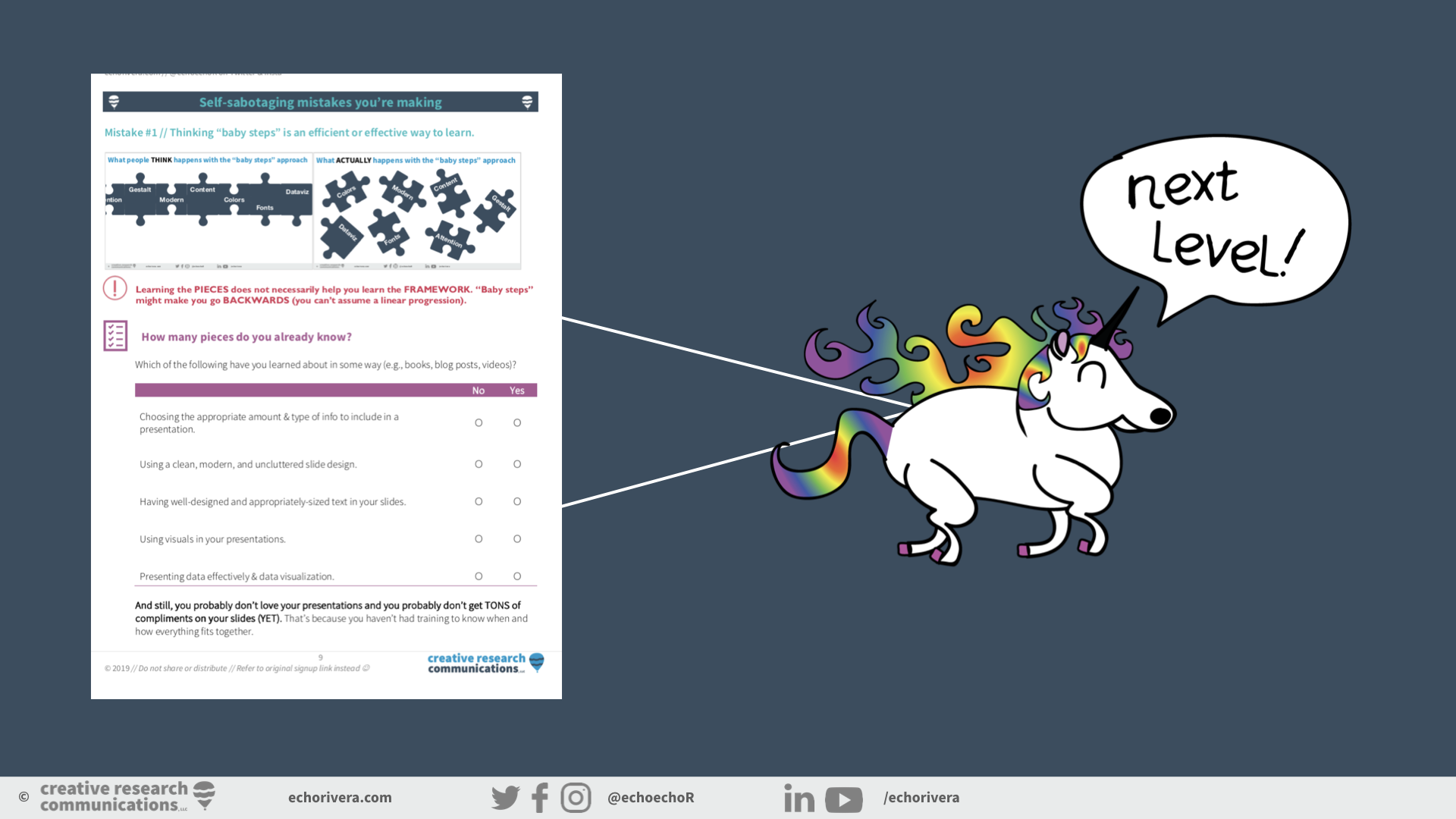[MISTAKES SERIES] Self-sabotaging mistakes that stop you from becoming an effective presenter (part 1: the puzzle)
Are you getting in your own way?
Are you making it hard for yourself to become an effective presenter?
If you’re like most academics, researchers, scientists, or other professionals, then yeah, you are, and you don’t even know it.
That’s why I’m working on this series about all those self-sabotaging mistakes you’re unintentionally making. These mistakes will stop you from designing effective presentations, regardless of what slide software you’re using (PowerPoint, Keynote, Google Slides, etc).
Before we get started, you might want to grab this free download that goes with the post.
It includes a refresher on the key points from this blog and some extra questions to see if you’re making additional mistakes that aren’t addressed in this post.
There are 3 major mistakes that most professionals make when they’re create slides for a technical, data-heavy, or academic topic. In this post, I’m going to talk about the first one.
The first mistake — or lie we tell ourselves — is that we can learn how to create effective and engaging presentations piece by piece, in small baby steps.
I hear this all the time from people. That they’re just trying to take “baby steps” when it comes to learning how to present more effectively.
Here’s why that’s just a lie we tell ourselves.
Here’s what people think happens when they approach learning effective presentation skills in a “baby step” kind of way.
They think they learn one piece (e.g., data visualization; PowerPoint tips), and then when they learn the next piece (e.g., typography) it just fits right in with the last skill they learned. And that each time they learn a new discrete skill (e.g., storyboarding and storytelling with data), that it just adds onto the last one,
Basically, people think all the tiny pieces will magically form into a completed puzzle.
Sounds great in theory, but that’s not what happens.
What actually happens is you learn each piece, but instead of fitting together they just float there. all, scattered and disorganized. And you’re left wondering how to actually fit everything in together, because it’s not obvious how they do.
How do I know? #BeenThereDoneThat
I know the problem with a “baby steps” approach to learning how to design effective presentations, because that’s what I did for YEARS.
I learned a little graphic design here, a little dataviz there…and I just assumed it’d equal good presentations one day.
But it didn’t.
Baby steps involved me spending almost 9 years spinning my wheels and barely making any progress.
Because, ultimately, baby steps are too small or random to make any real progress.
Read between the lines: Baby steps WASTES YOUR TIME.
Instead of baby steps, you should be taking STRATEGIC BIG STEPS.
So, it’s still a step-by-step approach (yay!)…but the key is this:
Every step you take improves your presentation skills (beyond just the design) and creates a noticeable improvement in your slides.
The strategic Big Steps are:
Unlearn all the bad presentation habits you’ve picked up over the years
Learn the entire slide-based communication framework
Apply the slide-based visual communication framework in three “waves”
Making a distinction between “baby" steps” and “big steps” might feel like a semantics game, but it’s not.
Here, take a look at a sample of my presentations for this entire 9 year time span. I also have a blog post about my old slides and progression towards presentation design.
Not a huge difference in design, right? That’s exactly what baby steps gets you, because you’re haphazardly applying random “tips and tricks” with no real framework, and no strategy.
“Baby steps” doesn’t work because you’ll always be applying only pieces of the framework. For example, I’d focus on animations, visuals, and a great storyboard without knowing how to also have good data visualization and an uncluttered design.
The main reason learning in pieces or “baby steps” is a problem is because you aren’t learning how to put everything together.
Trying to create effective presentations without a framework is kinda like trying to learn how to be a statistician by only learning how to click through SPSS menus, randomly.
Would it work to learn statistical analyses by first learning ANOVAs, then learning Multilevel modeling, then learning t-tests?
No. That’s a scattered approach, and doesn’t go in a logical order.
Academics, scientists, and evaluators are often shocked to hear that learning how to effectively communicate (when using slides) also has a logical order.
But that’s not even the only problem to worry about….
…If you aren’t learning an entire framework for how things fit together, you can’t even assume you’ll have LINEAR progress.
Below is a slide deck I made in 2010. I was alllll over that PowerPoint SmartArt (lol) and it has tons of text. But, I still tried to make my own template and it is a step in the right direction in terms of an uncluttered design.
BUT, I continued on with my “baby step” approach…and then the VERY NEXT YEAR I made slides that were 5 steps backwards!
Much more text, awful templates, terrible use of photos, and more bad design decisions.
Again, the reason I went backwards, instead of forwards, is because I hadn’t yet figured out the framework that finally helped me put it all together.
It wasn’t until I figured out how to apply everything together that my presentations appeared to change and improve almost overnight.
Because only when this entire framework was applied, did I know how to create presentations that had memorable content, were easy to follow, shared powerful and convincing data, and were engaging from start to finish.
So another reason baby steps is a problem is because it could be making you go backwards. Again, that means it’s WASTING YOUR TIME.
That’s why strategic BIG steps are the better way to learn effective presenting.
Instead of baby steps, I train folks to take BIG steps, according to the slide-based communication framework I’ve mentioned in this post.
And it looks a little something like this…
Strategic Step #1
The first step is to focus on the foundational elements for each layer. These are the easiest strategies I teach: the ones have the biggest impact with the least amount of effort.
Most people could stop here if they wanted.
Because they’re applying at least some part (the foundational part) of EACH layer, in ONE presentation, their presentations will be effective and significantly better than the #DeathByPowerpoint that’s the current status quo.
In fact, I teach Step #1 in my three-part training series, Captivate with Stellar Slides.
It’s available for individuals or groups/organizations as an online course or live webinars. Get in touch if you’re interested in learning more.
Strategic Step #2
Once Step #1 becomes your new habit and becomes easy, you can decide whether you want to keep going and create more advanced presentations. If so, move onto Step #2.
What you do in this step, is you start building on these foundations. The good news is that because you’re already applying the foundational strategies in each layer, you can now start to pick and choose which layers you want to focus on in this step.
So, for example, you could focus on learning more advanced storytelling with data skills. Then, you can move on to more advanced graphic design skills after that (and so on).
This is as close to “baby steps” as you’re going to get with me :) But it only works because we’ve already completed Step #2 AND because now you have a strategy.
Strategic Step #3
And just like before, once everything in Step #2 becomes your new habit, then you can build on that, and start applying expert level strategies. Just like with Step #2, you can be a little picky here and focus on one layer at a time, because you already have advanced-level strategies applied for each layer.
By the way, I also have an online program for those who want to learn all three steps and become experts at slide-based visual communication. It’s called Blast Off to Stellar Slides.
Again, you still get to take a step-by-step approach, but it’s informed by a comprehensive framework and implemented in such a way that you’re always making linear progress.
But that’s enough for today’s post because now you know that trying to take a “baby steps” approach to designing engaging presentations won’t really work. I hope you’re interested in learning the other two mistakes. Stay tuned for that future post!
In the meantime, if you’re ready to put the pieces together — and only make linear progress with your presentation design skills from now on — I can help you!
If you’re looking for some presentation training & coaching, I have:
professional development / training webinars (for individuals and groups)
group mentoring,
online courses,
and individual training sessions
If you’re looking for some custom slide design work, I also do that!
Contact me for more details.
Don’t leave without grabbing this free download. It includes a refresher on what we talked about and some extra questions for you to answer to see if you’re making even more mistakes than what I talked about in this post.
with joy,
Echo Rivera, PhD


















